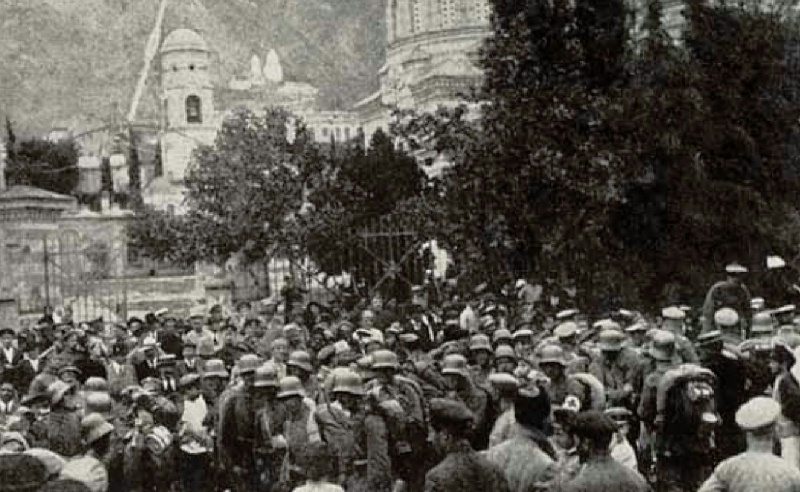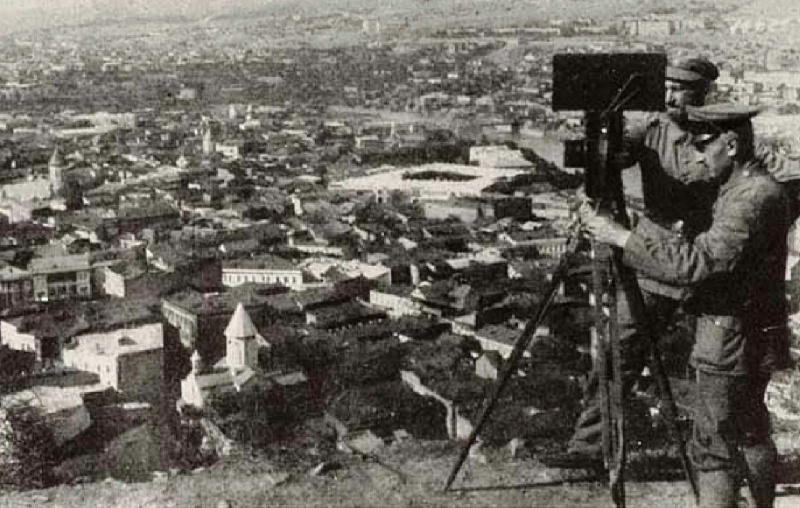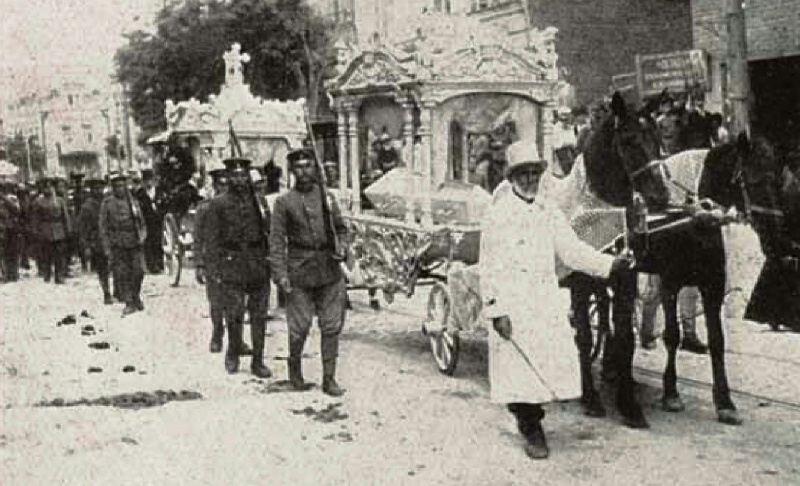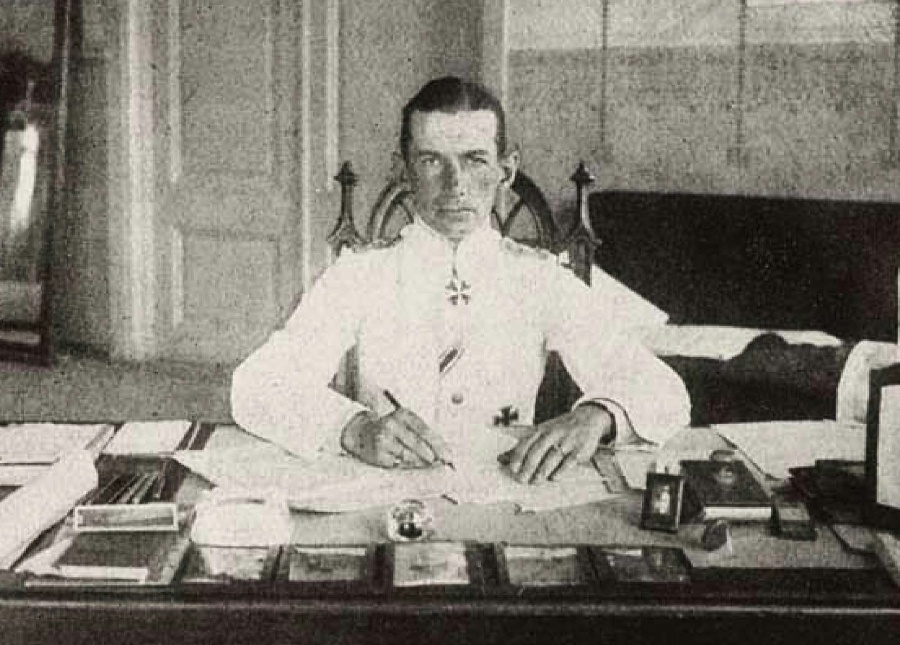| |
The German Caucasian Expedition
Georgia 1918
|
|
| |
| |
|
|
|
Background to the
Caucasian Expedition
As the
Russian Empire descended into chaos and revolution, Georgia declared herself an independent republic on 26th May 1918. Meanwhile Bolshevik, White Russian, British and Ottoman armies all headed for
Georgia with the hopes of capturing her rich oilfields.
Germany also
sent an army (known as the Caucasian Expedition or the
Military Mission in the Caucasus), consisting of 3,000 mostly
Bavarian troops under the command of Generalmajor Kress von Kressenstein.
Soon after their arrival in Georgia, they fought skirmishes with
local tribesmen and Ottoman army units. They arrived
in Tiflis, the Georgian capital, in June 1918 where they were welcomed as
defenders against the Bolsheviks. The revolution
in Germany and the end of the war finally caused their mission to be aborted.
Field Grey Uniforms of the
Caucasian Expedition
The majority of
photographs I have seen of the Caucasian Expedition show them wearing standard
field grey German army
uniforms as worn on European Fronts. Many of the units of the
Expedition were deployed directly from service on the
Eastern Front and kept the same uniforms. These uniforms consisted mostly of
field grey modified 1910 or 1915 tunics, field caps and steel
helmets
(see
German Uniforms on Ottoman Fronts Page).
The Illustration on
the Right is based on a photograph of a Storm Trooper of the
10th Assault Battalion ("Sturm-Batallion Nr. 10") taken in Georgia in
1918.
He is dressed and equipped exactly as he would have been on the
Western Front at this late stage in the war. He wears the 1918
steel helmet painted with angular camouflage pattern. His tunic
is the 1915 "Bluse" simplified tunic in field grey with
field grey shoulder straps piped in white with the battalion
number in red. His
trousers are slate grey with red piping. Both the tunic and trousers have
the leather reinforcement patches worn by the Assault
Battalions. He wears field grey
puttees and blackened leather ankle boots. His equipment is blackened leather
with 1909
ammunition pouches supplemented by additional canvas ammunition pouches carried
around his neck. He is armed with a Mauser K98az carbine and a trench knife. |
|

Storm Trooper
10th Assault Battalion
Georgia
1918 |
|
|
| |
|
|
| |
Tropical
Uniforms of the
Caucasian Expedition
The Caucasian Expedition were
authorised as of 13th June 1918 to wear the same
Tropical Uniforms as the
Asienkorps. I have been able to find very
few photographs to prove the wide scale use of tropical uniforms in Georgia.
One
photograph (published in "Tropenhelme der kaiserliche
Marine, der Ostasiatischen Truppen und der Schutztruppen" by
U Schiers)
is captioned as a soldier from the
Caucasus Expedition taken in the "Limburg
Mountains". He is wearing an Asienkorps 1917 tropical uniform with a peacetime white
leather parade belt and a 1900 Bortfeldt tropical helmet. He is
the only figure in the photograph. It
cannot be confirmed for certain if this is indeed a soldier from
the Caucasian Expedition (I have so far been unable to locate the
Limburg Mountains on a map of the Caucasus. The only reference I
can find to them is a range of hills in the South of the
Netherlands). If this photograph does indeed show
a member of the Caucasian Expedition it does not prove the
widespread use of tropical uniforms.
At least one photograph clearly shows a German
officer wearing a privately purchased white tropical uniform as worn by
German army officers on several fronts (such as Palestine, China and those
Seconded to the Colonies).
Some other photographs of
Caucasus Expedition are not so clear and may possibly be either field grey
or khaki. So as to the question of whether not not khaki uniforms were issued in quantity
to the troops in Georgia, I
would invite the reader to examine the period photographs below and decide for yourself.
The problem is of course that it is very difficult to differentiate between field grey and khaki in monochrome
photos so we must rely on other clues. The most telling of which
would be that peaked field caps had arm-of-service coloured hatbands on the
field grey version but khaki hatbands on the khaki cap. Peakless caps were
only issued in field grey. The second most visible clue in monochrome
photographs is that khaki tunics usually had six buttons down the front,
while the field grey 1910 tunic had eight buttons and the 1915 other ranks
tunic had concealed buttons. |
|
| |
|
|
|
| |
Period Photographs
from "Grosser Bilderatlas des Weltkrieges"
F Bruckmann, Munich 1919
at
University of Wisconsin Digital Collections and
WikiCommons |
|
| |
 |
|
| |
German troops on the March in Georgia
These soldiers
appear to be wearing field grey 1915 uniforms with steel helmets. The
driver of the wagon on the left has an other ranks peakless field grey cap,
he can also clearly be seen to wear puttees with short ankle boots. |
|
| |
|
|
| |
 |
|
| |
German Officers and NCOs talking with local Tartars
The bareheaded NCO in the centre clearly wears a 1915 field grey tunic
with lace denoting his NCO rank on the collar. His trousers have
leather reinforcement patches, a distinction usually only worn by
Storm Troops, showing him (and probably the other figures in the group)
to be a member of the 10th Assault Battalion. The Germans all appear to
be wearing puttees and short ankle boots.
The officers to the left of the
photograph wear peaked field caps. Note the dark hatband of the officer
nearest the centre (possibly the Storm Troops black hatband piped in
red). This difference between the hatband and cap colour would seem to
indicate that the cap is a field grey one. The shade of the cap also
matches that of the tunic and trousers, indicating that they are all
field grey. The cut of the officers tunics (with both breast and hip pockets)
could be seen on either khaki or field grey uniforms.
In the background can be seen another two German soldiers, one to the
left has a field grey other ranks peakless cap. The 10th Assault
Battalion was a Prussian unit and the cap cockades would therefore be
the imperial cockade above the Prussian one (black/white/black). The
other soldier in the background further to the right
has a steel helmet and badge on the left breast of his 1915 field grey
tunic which may be a wound badge or possibly an Iron Cross, first class.
He appears to have an NCOs rank button on his collar. |
|
| |
|
|
| |
 |
|
| |
German Troops in Tiflis
These soldiers appear to be
wearing field grey 1915 uniforms with steel helmets. Most of the men
wear backpacks with tent quarters wrapped around them and canteens hung
on the back, some have additional ammunition bandoliers around their
necks and one clearly has a red cross armband. |
|
| |
|
|
| |
 |
|
| |
German Troops above Tiflis using
what looks like a Movie Camera
From this photograph it is very difficult to be certain if they
are wearing field grey or khaki. They both wear peaked field caps, though
each looks quite different. The one
on the right in the foreground had a
dark arm of service hatband, polished leather peak and appears to have a
wire retaining loop to hold the top of the cap in place. This would
indicate that it is a field grey NCOs cap. The one behind has no
retaining loop, giving it a more shapeless appearance, no reflective peak
and the hatband appears to be lighter shade, more similar to the cap itself,
possibly
but not certainly the same colour. The other ranks 1917 field grey cap
had a grey leather peak and no retaining loop as did the Asienkorps
khaki cap for other ranks. This photograph could show either. Note also
the cap of the man in the background has two cockades, the imperial
cockade above a state cockade. The state cockade appears quite light in
the photograph and is probably the white/blue/white Bavarian cockade
rather than the black/white/black Prussian cockade.
Their uniforms cannot be seen very
clearly. From the folds in their sleeves it would appear that they are
lightweight tunics. Possibly lightweight field grey uniforms as worn in
Macedonia. The figure in the background
appears to have his tunic buttons quite closely together, indicating that
they
may be on an eight buttoned field grey 1910 tunic (or a lightweight
modified version of the 1910 tunic with plain cuffs) rather than an
Asienkorps six buttoned khaki tunic. Note the NCOs rank button on the
collar of the foreground figure.
|
|
| |
|
|
| |
 |
|
| |
Georgian and German Troops
The Georgians are on the
left wearing a mixture of Tsarist Russian uniforms and civilian
attire. On the right are some German officers in peaked field caps
(and one soldier in a peakless cap) note their state and imperial
cockades. The German officers seem to be wearing field grey 1915 tunics
with pockets one has Litzen from an elite unit. The figure with the
lighter tunic may be wearing an officers Litewka in pale grey with arm
of service collar patches. Tropical uniforms did not normally have collar patches
or Litzen. |
|
| |
|
|
| |
 |
|
| |
Funeral in Georgia
This is possibly the funeral of Oberjäger Alois
Hitzler of the 2nd Company of the 1st Bavarian Reserve Jäger Battalion
who died on 8th July 1918). A local undertaker in white leads
the funeral carriage.
The German troops behind him wear peaked field caps, the funeral
escort would presumably be from the same unit at the deceased and would
therefore have both imperial and Bavarian cockades on their caps. As
mentioned above peaked field caps for other ranks were made in both
khaki and field grey by 1918.
The soldier marching at
the front appears to wear a six buttoned tunic, which seems to be
lighter than that of the soldier behind him (though that could simply be
how the sunlight is falling). Although from the quality of the
photograph it is impossible to be certain, this is the strongest
evidence I have so far seen for the six-buttoned Asienkorps style khaki
uniforms being issued to the soldiers of the Caucasian Expedition.
German field grey uniforms did not have six buttons, the 1910 uniform
having eight and the 1915 uniform having a concealed front. There is a
chance it might be an 1895 cotton fatigue uniform, which had five
buttons, but these usually had shorter skirts without pockets (see
German Army in Macedonia).
The soldier behind him
has a darker uniform with what looks like eight buttons. This probably a
field grey modified 1910 tunic.
|
|
| |
|
|
| |
 |
|
| |
|
|
| |
Rittmeister Jenö von Egan-Krieger, chief of
General Staff of the German Mission in
Georgia, 1918
He wears a privately purchased white tropical uniform as
was often worn by German army officers on overseas postings.
It was of the same cut as the
Schutztruppe 1896 White
Uniform but
without the Schutztruppe blue piping. Although privately purchased
uniforms varied in cut, it generally had a stand and fall collar, plain
turn back cuffs, four buttoned and pleated pockets and six buttons down the front.
The buttons were the same as worn by the home regiment (in this case
Prussian crown buttons) as were the officers shoulder straps (in this
case in Prussian white metallic lace with threads of black and with two pips for the rank of cavalry captain or "Rittmeister").
He wears an Iron Cross first class on his left breast pocket, an Iron
Cross second class ribbon in his second buttonhole and another medal
that cannot quite be identified from this photograph at his throat.
| |
Jenö
Edward Jakob Ernst von Egan-Krieger
(1886-1965) was born in
Scloß Bernstein in Burgenland,
a largely German speaking area then part of Hungary (now in the Republic
of Austria) but joined the German
army in 1904. He was commissioned into the 1st Prussian Life Hussar Regt ("Leib-Husaren
Regiment Nr.1") and rose through the ranks to Oberleutnant by the
outbreak of war and then to Rittmeister in December 1914. He served in
various staff and supply commands with the cavalry and flying corps
during the war and was chief of staff to the Military Mission in Georgia until
August 1918. He was severely wounded on the Western Front as battalion
commander in the 51st
Lower Silesia Infantry Regt ("4. Niederschlesisches
Infanterie-Regiment Nr.51") less
than a month before the armistice. In 1920 he retired from the army and soon after became involved in
the Stahlhelm veterans organisation and later the
German National People's Party (DNVP), a
Conservative-Nationalist
political party. For a short while in 1933-34 he was the flight adjutant
to the Kaiser in exile. After the Nazis came to power
the DNVP was abolished and in 1934 Egan-Krieger was arrested as part of the "Röhm-Putsch" clamp
down on political activists. He was released from Potsdam prison a week
later and soon after joined the newly formed Luftwaffe serving on the
staff of the Condor Legion during the Spanish Civil War. He was promoted
through Oberst
in 1939, Generalmajor in 1940 and Generalleutnant in 1942. He finally
retired from active service in 1944. After the war he was detained by
American authorities until 1947. He died in Cologne at the age of 78.
Recommended External Link -
Jenö von Egan-Krieger
Biography
on the
Axis Biographical Research Website |
|
|
|
| |
|
|
|
| |
|
|
|
| |

Photo © Matjaz Voglar |
The Georgian
Order of St Tamara Medal
A final mention on this page has to be given to the
Order of St Tamara.
This was a medal awarded to members of the German Caucasus Expedition by the
fledgling Georgian Government on 4th November 1918.
It was named after
the 12th-13th Century Sainted Queen of Georgia. It consisted of an image
of Queen Tamara within a circle containing Georgian lettering and the
date 1915 on an eight pointed Brunswick star badge worn on the left
breast. It could also be worn as a medal ribbon without the medal (such
as on miniature bars). The medal ribbon was dark red with black
horizontal bars in the centre.
Less than 5,000 of these medals (some say
as few as 1,400) were awarded in total, most of the existing medals were
privately made in Germany after the First World War for veterans of the
Georgian Campaign.
Recommended External Links-
Sections on the Order of St Tamara at
The Orders and Medals Society of America,
The
Gentlemen's Military Interest Club and Wehrmacht
Awards and
Wikipedia
|
|
| |
|
|
|
|
|
Organisation of the
Caucasus Expedition 1918
from "Imperial German Army 1914-18"
by H Cron and "The
Caucasus Expedition" at the AHF
|
| |
|
| |
Infantry |
| |
|
29th Bavarian Jäger Regt ("29.
Königlich Bayerisches Jäger-Regiment") |
| |
|
|
7th Bavarian Reserve Jäger Btn ("7.
Königlich Bayerisches Reserve Jäger-Batallion") |
| |
|
|
9th Bavarian Reserve Jäger Btn
("9. Königlich Bayerisches Reserve Jäger-Batallion") |
| |
|
15th Bavarian Jäger Regt
("15. Königlich Bayerisches Jäger-Regiment")- raised August 1918 |
| |
|
|
1st Bavarian Reserve Jäger Btn ("1.
Königlich Bayerisches Reserve Jäger-Batallion")- from the 29th Bavarian Jäger Regt |
| |
|
|
Caucasian Railway Protection Btn -
raised from former German
Prisoners of War |
| |
|
10th Assault Btn
("10. Sturmbattalion") |
| |
|
|
Assault Company |
| |
|
|
Machine Gun Company
(with 12 machine guns) |
| |
|
|
Trench Mortar/Mine
Thrower Company (with 8 mortars) |
| |
|
|
Garrison Company -
raised from former German
Prisoners of War |
| |
Cavalry |
| |
|
7th Bavarian Cavalry Brigade
("7. Königlich Bayerische Kavallerie-Brigade") |
| |
|
|
5th Bavarian Light
Horse
Regt ("5. Königlich Bayerisches Chevaulegers-Regiment "Erzherzog
Friedrich von Österreich"") |
| |
|
|
4th Bavarian Light
Horse
Regt ("4. Königlich Bayerisches Chevaulegers-Regiment "König"")- deployed September
1918 |
| |
Other Armed Units |
| |
|
176th
Mortar Company ("176. Mörser Kompanie") |
| |
|
2nd
Motorised Battalion, 65th Reserve Field Artillery Regt ("II. Batallion,
Reserve Feld Artillerie Regiment Nr 65") |
| |
|
Armoured
Car Machine Gun Unit ("Panzer-Kraftwagen-MG-Abteilung") |
| |
|
|
1 x Daimler/15
Armoured Car (modernised in 1917)
1 x Ehrhardt/15 Armoured Car (modernised in 1917)
1 x Ehrhardt/17 Armoured Car
1 x Minerva Armoured Car (modified captured Belgian car)
1 x Daimler Machine Gun Carrier
Possibly 2 x Austin Armoured Cars (captured Russian cars)
Miscellaneous softskin vehicles |
| |
|
28th Aviation Detachment |
| |
Non-Combatant Units |
|
|
1750th Signal Section |
Sources and Recommended Reading-
"Like Hidden Fire" by Peter Hopkirk (see Book
Reviews Page)
Discussion on the
Caucasus Expedition at the Axis History Forum
"An Iron Cross For
Friendly Fire" at the Wehrmacht
Awards Forum
Wikipedia Page on the
German Caucasus Expedition
"Grosser Bilderatlas des Weltkrieges"
by F Bruckmann, Munich 1919 at
University of Wisconsin Digital Collections
"Imperial German Army 1914-18"
by Hermann Cron
"Die feldgraue Uniformierung
des deutschen Heeres 1907-1918" by J Kraus
and W Hanne
(Verlag
Militaria 2009)
"Tropenhelme der kaiserliche Marine, der
Ostasiatischen Truppen und der Schutztruppen" by
Ulrich Schiers (see Book Reviews Page)
"The German Army in World War One (3)" N Thomas and R
Bujiero
Wikipedia
Page on the Caucasus Campaign
"Meine Mission im
Kaukasus" by Kress von Kressentein |
|
|
|
Please
contact me here if you have more
information or photos on this topic.
Back to
Main Menu for German Colonial Uniforms
|
|